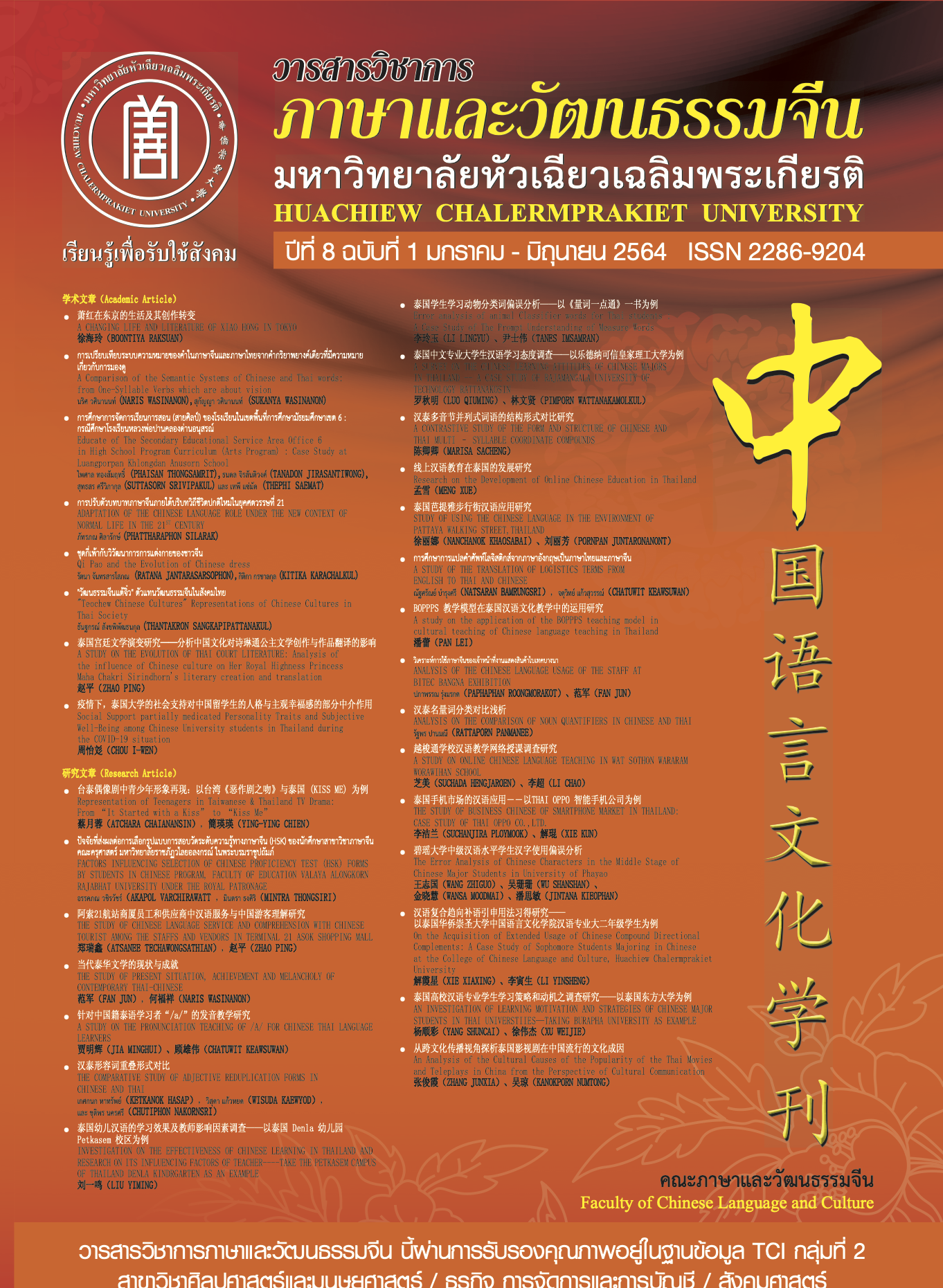汉泰形容词重叠形式对比
Keywords:
Chinese language, Thai language, Adjective reduplication formsAbstract
This paper makes a comparative analysis of the reduplication forms of adjectives in Chinese and Thai to find out their similarities and differences. Through the summary and comparative analysis of adjective reduplication in Chinese and Thai, We find that there are six types of adjective reduplication in Chinese: AA type, ABB type, AAB type, AABB type, ABAB type and A里AB type; while there are eight types of adjective reduplication in Thai: AA type, AAB type, AABB type, ABAB type, AแสนA type, AB แสนAB type, modulation type and harmonic type. There are both similarities and differences between them: First, there are four common forms of adjective reduplication in Chinese and Thai, including AA, AAB, AABB and ABAB. Second, the personality of adjective reduplication in Chinese and Thai; abb and a Li AB are unique in Chinese, but there are no two forms of adjective reduplication in Thai. There are also unique adjective reduplication forms in Thai, such as A แสน A type, AB แสน AB type, modulation type and harmonic type. Thirdly, Chinese ABAB reduplication is generally composed of two syllable state adjectives, while Thai ABAB reduplication is composed of property adjectives, It is not composed of state adjectives, and a basic form in Chinese state adjectives will overlap into two or three forms, which is not found in Thai. Fourthly, some monosyllabic adjectives can not be overlapped in Chinese, but in Thai.
In addition, some monosyllabic adjective reduplication acts as the same sentence element
(as attribute), but the semantics is different.
Therefore, Thai learners need to distinguish between reduplicated and non reduplicated adjectives when using Chinese monosyllabic adjectives. Through the above results, it deepens the academic understanding of the commonness and individuality of Chinese and Thai languages, and provides a new perspective for the future comparative study between Chinese and foreign languages.
References
元传军. 现代汉语形容词重叠式研究: [硕士学位论文].[D].南京师范大学,2002.
孔美月. 汉泰形容词重叠式对比研究. [J]. 广西师范大学, 2010, (16): 6-9.
田笑. 泰国学习者习得形容词重叠式的常见偏误例释. [J]. 湖南市学院学报,2013,(32): 47-48.
吕叔湘. 形容词使用情况的一个考察. [J]. 中国语文,1965,(6): 13-14.
孙益欣. 从汉泰语言差异看对泰汉语教. [J]. 学河北大学,2003,(1): 21-22.
李禄兴. 新HSK 5000词分级词典(一~三级). [M]. 北京:北京语言大学出版社,2013.
李禄兴. 新HSK 5000词分级词典(四~五级). [M]. 北京:北京语言大学出版社,2014.
李禄兴. 新HSK 5000词分级词典(六级). [M]. 北京:北京语言大学出版社,2014.
杨欢. 泰语形容词重叠形式与意义: [硕士学位论文].[D].北京大学,2015.
李宇明. 双音性质形容词的ABAB式重叠. [J]. 汉语学习,1996,(4): 24-27.
李春雨. 现代汉语形容词重叠式研究: [硕士学位论文].[D].吉林大学,2016.
邱莉芹. 现代汉语形容词重叠的形式特征. [J]. 连云港师范高等专科学校学报,2001,(2): 34-37.
张斌、方绪军. 现代汉语实词. [M]. 上海: 华东师范大学出版社,2000.
陈楚华. 汉泰副词对比: [硕士学位论文]. [D].南京师范大学,2005.
张睿. 泰语词类重叠现象概说. [J]. 剑南文学(经典教苑),2012,(11): 148.
罗伯东. 汉泰重叠式对比研究: [硕士学位论文].[D].广西师范大学,2008.
罗润锋. 王朔作品中形容词重叠式研究: [硕士学位论文].[D].上海师范大学,2012.
徐建波. 现代汉语形容词重叠研究: [硕士学位论文].[D].上海外国语大学,2009.
黄迎丽. 汉泰形容词句法位置及功能的对比研究. [J]. 现代语文语言研究版,2013,(7):129-131.
崔娅辉. 现代汉语形容词重叠式作状语和补语的对比研究: [硕士学位论文].[D].黑龙江大学,2009.
龚继华. 谈谈动词和形容词的重叠. [J]. 天津师院学报, 1981, (1): 56-60.
傅增有. 泰语和汉语重叠词对比研究: [硕士学位论文].[D].朱拉隆宫大学, 2006.
赖彩妮. 泰国学习者学习汉语形容词重叠习得偏误分析:[硕士学位论文].[D].厦门大学,2011.
裴晓睿. 泰语语法. [M]. 北京: 北京大学出版社,2017.
Amara Prasitratthasin. Thai standard grammar. [D]. Thailand Fund Research Department,2011.
Banjob Phanthumetha. Characteristic of Thai Language. [M]. Bangkok: Kuroosapha Press,1971.
Direkchai Mahattanasin. Structure of Thai Language. [M]. Chiangmai: Suriwong Books Press,1973.
Duangphon Jitjamnong. Characteristic of Thai Language. [M]. Padtani:Tem Press,1986.
Jitnipha Srisai. Thai Language. [M]. Bangkok:Don Press,1981.
Kanjana Naksakun. Parallelism in the Use and Construction of Certain Grammatical and Lexical term in Cambodian and Thai : A Typological Comparative Study.[D].A Doctoral Thesis submitted to the University of London,1971.
Lin Li. Reduplication in Mandarin and Thai. [D]. Mahasarakham University, 2012.
Nuttathida Chakshuraksha. “Prosodic Structure And Redupucation In Thai”.[J]. Working Papers of the Linguistics Circle.journals.uvic.ca, 1994(12):32-34.
Richard B. Noss.Thai: Reference Grammar. [M]. United States:U.S.Government Printing Office,1964.
Uprakit Sinlapasan. Thai Grammar. [M]. Bangkok:Thai Wattanaphanich Press,1918.
ราชบัณฑิตยสถาน. พจนานุกรมฉบับราชบัณฑิตยสถาน พ.ศ. 2542. [M]. กรุงเทพฯ: นานมีบุคส์พับลิเคชันส์,2546.
Downloads
Published
How to Cite
Issue
Section
License
บทความที่ได้รับการตีพิมพ์เป็นลิขสิทธิ์ของวารสารภาษาและวัฒนธรรมจีน มหาวิทยาลัยหัวเฉียวเฉลิมพระเกียรติ
บทความใน “วารสารวิชาการภาษาและวัฒนธรรมจีน” เป็นทรรศนะของผู้เขียนโดยเฉพาะ กองบรรณาธิการไม่มีส่วนในความคิดเห็นในข้อเขียนเหล่านั้น




